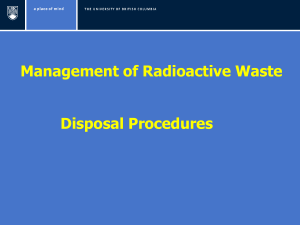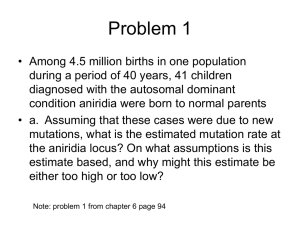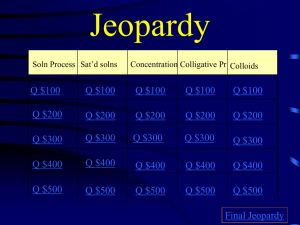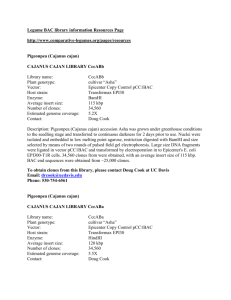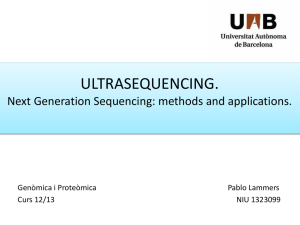file - BioMed Central
advertisement
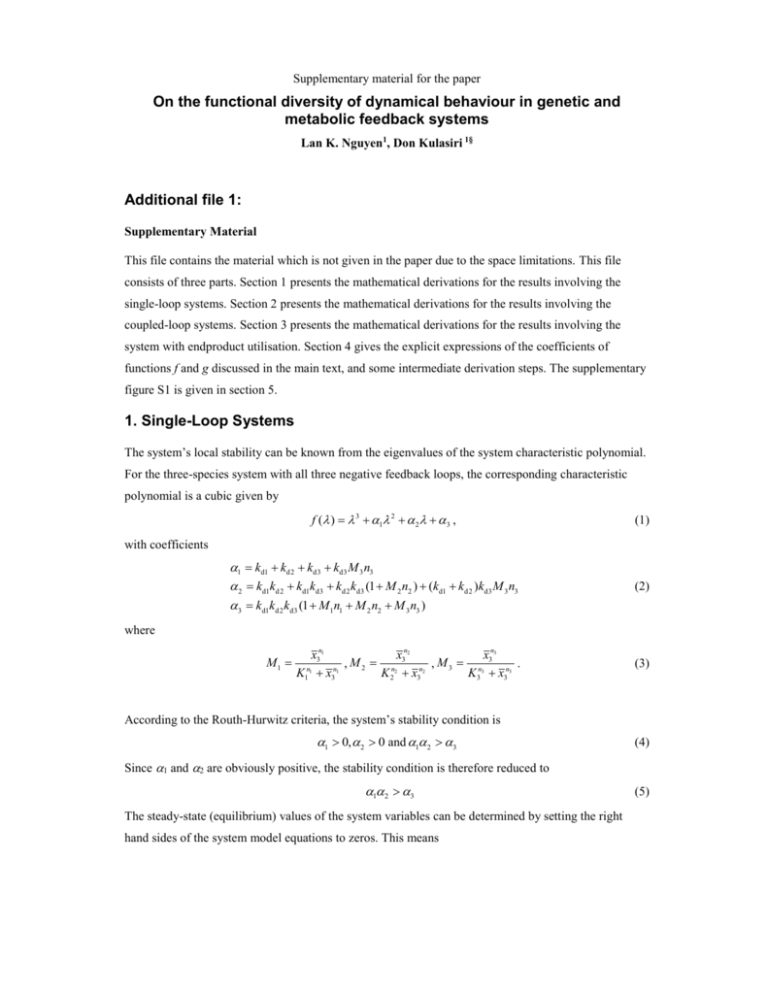
Supplementary material for the paper
On the functional diversity of dynamical behaviour in genetic and
metabolic feedback systems
Lan K. Nguyen1, Don Kulasiri 1§
Additional file 1:
Supplementary Material
This file contains the material which is not given in the paper due to the space limitations. This file
consists of three parts. Section 1 presents the mathematical derivations for the results involving the
single-loop systems. Section 2 presents the mathematical derivations for the results involving the
coupled-loop systems. Section 3 presents the mathematical derivations for the results involving the
system with endproduct utilisation. Section 4 gives the explicit expressions of the coefficients of
functions f and g discussed in the main text, and some intermediate derivation steps. The supplementary
figure S1 is given in section 5.
1. Single-Loop Systems
The system’s local stability can be known from the eigenvalues of the system characteristic polynomial.
For the three-species system with all three negative feedback loops, the corresponding characteristic
polynomial is a cubic given by
f ( ) 3 1 2 2 3 ,
(1)
with coefficients
1 kd1 kd2 kd3 kd3 M 3 n3
2 kd1kd2 kd1kd3 kd2 kd3 (1 M 2 n2 ) (kd1 kd2 )kd3 M 3 n3
3 kd1kd2 kd3 (1 M1n1 M 2 n2 M 3 n3 )
(2)
x3n1
x n2
x n3
, M 2 n2 3 n2 , M 3 n3 3 n3 .
n1
K x3
K 2 x3
K 3 x3
(3)
where
M1
n1
1
According to the Routh-Hurwitz criteria, the system’s stability condition is
1 0, 2 0 and 1 2 3
(4)
Since 1 and 2 are obviously positive, the stability condition is therefore reduced to
1 2 3
The steady-state (equilibrium) values of the system variables can be determined by setting the right
hand sides of the system model equations to zeros. This means
(5)
k1
K1n1
kd1 x1 0
K1n1 x3n1
k2 x1
K 2n2
kd2 x2 0
K 2n2 x3n2
k3 x2
K 3n3
kd3 x3 0
K 3n3 x3n3
(6)
Working from the bottom of equations (6) up we have
k3
K n3
k k
K n2 K n3
x2 n3 3 n3 3 2 x1 n2 2 n2 n3 3 n3
kd3 K3 x3
kd3 kd2 K 2 x3 K3 x3
k k k
K n1 K n2 K n3
3 2 1 n1 1 n1 n2 2 n2 n3 3 n3
kd3 kd2 kd1 K1 x3 K 2 x3 K3 x3
kk k
K3n3
K1n1
K 2n2
1 2 3
kd1kd2 kd3 K1n1 x3n1 K 2n2 x3n2 K3n3 x3n3
x3
(7)
Substitute (3) into (7) we have the equilibrium equation reduced to
(1 M1 )(1 M 2 )(1 M 3 ) Ax3 , with A
kd1kd2 kd3
k1k2 k3
(8)
1.1. System L13
1.1.1 Stability Condition
In this case we have M2=M3=0, equation (5) now becomes after substitution from (2):
(kd1 kd2 kd3 )(kd1kd2 kd1kd3 kd2 kd3 ) kd1kd2 kd3 (1 M1n1 ) ,
or
M1n1
(kd1 kd2 )(kd2 kd3 )(kd3 kd1 )
.
kd1kd2 kd3
(9)
Denote the right hand side of (9) by B then the stability condition becomes
M1
B
.
n1
(10)
1.1.2 Critical n1
Applying the Cauchy-Schwartz inequality for 2 variables we have:
kd1 kd2 2 kd1kd2
kd2 kd3 2 kd2 kd3
kd3 kd1 2 kd3 kd1
Multiply these inequalities together we obtain B 8. Equality occurs when kd1= kd2= kd3. Since M1<1
always, condition (6) is always satisfied if n1 8; in this case the system is always stable regardless of
the other parameters’ values.
1.1.3 Choice of Parameters for Oscillatory System
Because B is a continuous function of kd1, kd2, kd3 with its minimum is 8, B therefore can take any values
that is greater than 8 with some kd1, kd2, kd3. For example, we choose kd1= k*kd2=k*kd3 we have
B
2(1 k )2
as k .
k
If n1>8, this means that there exists an indefinite number of parameter sets {kd1, kd2, kd3} that makes
B<n1 and so B / n1 1 . On the other hand, we can always choose K1 large enough to make M1 closer to 1
and exceeds B / n1 . This violates the stability condition (10) and hence destabilises the system. Because
the choice of kd1, kd2, kd3 and K1 are independent, the choice of a proper parameter set is thus justified.
1.1.4 Derivation of the threshold K1thesh
Here we derive the stability condition for the inverse feedback strength indicator K1 as function of the
remaining model parameters.
Substitute M2=M3=0 into equation (8), the equilibrium equation for system L13 reads
1 M1 Ax3 .
(11)
1
M1 n1
x n1
Since M 1 n1 3 n1 , we have x3 K1
. Substitute (11) into this we obtain
K1 x3
1 M1
1
M1 n1
1 M1 AK1
,
1 M1
or
1
1 M1 1 M1 n1
K1
fun( M1 ) .
A M1
(12)
Equation (12) shows that K1 is a function of M1. This function is strictly decreasing with respect to M1
due to (note that 0<M1<1)
1
fun( M1 )
1 1 M1 n
1
1
0.
M1
A M1 M1n1
1
As a result, the stability condition (10) is equivalent to:
B (n B)11/ n1
K1 fun 1
.
An1 B1/ n1
n1
Denote the right hand side of (13) K1thresh, the K1’s threshold value, it acts as a function of the Hill
coefficient n1 and two compound variables A and B. This threshold value of K1 bifurcates the system
between the stable and oscillatory dynamics.
(13)
1.1.5 Critical K1
Here we find the analytical form of the critical K1 discussed in the text. We will show that this value is
1/A for the range of n1 of interest.
Put k
n1
then n1 k B . Note that we only need to consider k 1 (so that n1 B). Condition (13) now
B
transforms to
K1thresh
If 1 k < 2 then trivially K1thresh
If k 2, we have (since B 8)
therefore K1thresh
1
1 k 1
kB
(
k
1)
.
A k
1
A
(14)
(16)
1
1
k 1
k 1
(k 1) kB
(k 1) 8k . This function is < 1 for k 1000,
k
k
1
A
(17)
for k up to 1000 or n1 up to 8000 (this well includes the plausible range of n1).
Moreover, since
1
k 1
1
lim
(k 1) kB 1 then lim K1thresh ,
k
k
A
k
combining (16-18), we can conclude that the critical value for K1 is
(18)
1
.
A
1.1.6 Effects of the Degradation rate on B
Here, we will investigate conditions under which B is low or high.
Put a kd2 / kd1 , b kd3 / kd2 and c kd1 / kd3 we obtain
B (a 1)(b 1)(c 1) with abc 1 .
B is large when either a, b, or c is large; meaning among the degradation parameters, one is many folds
greater than another ( kdi
kd j with i, j 1, 2,3 ). On the other hand, B is low when kd1 kd2 kd3 .
1.2. System L14
1.2.1 Critical n1 (Proving B ≥ 4)
B in this case has the following form
B
(kd1 kd2 )(kd1 kd3 )(kd2 kd3 )(kd1 kd4 )(kd2 kd4 )(kd3 kd4 )
kd1kd2 kd3 kd4 (kd1 kd2 kd3 kd4 )2
Here we show that B ≥ 4 for all positive degradation rates.
Note that
(19)
(kd1 kd2 )(kd2 kd3 )(kd3 kd4 )(kd4 kd1 ) (kd1 kd2 kd3 kd4 )(kd1kd2 kd3 kd1kd2 kd 4 kd1kd3 kd 4 kd2 kd3 kd4 )
(kd1kd3 kd2 kd4 ) 2 0,
which leads to
(kd1 kd2 )(kd2 kd3 )(kd3 kd4 )(kd4 kd1 )(kd1 kd3 )(kd2 kd4 )
(kd1 kd2 kd3 kd4 )(kd1kd2 kd3 kd1kd2 kd4 kd1kd3 kd4 kd2 kd3 kd4 )(kd1 kd3 )(kd2 kd4 )
(kd1 kd2 kd3 kd4 ) 4kd1kd2 kd3 kd4 (kd1 kd2 kd3 kd4 ) (kd1 kd3 ) 2 (kd2 kd4 )kd2 kd4 (kd2 kd4 ) 2 (kd1 kd3 )kd1kd3
4kd1kd2 kd3 kd4 (kd1 kd2 kd3 kd4 ) 2
This means B 4 and equality occurs when kd1= kd2= kd3= kd4.
1.2.2 Choice of Parameters for Oscillatory System
Similar to section 1.1.2
2. Coupled-Loop Systems
System L1,2
3 - Derivation of the Critical K1
To derive this K1crit, we express the SC in terms of M2 and perform analysis on the M1-M2 coordinate:
M2(M1) > g(M1),
with
1
1 M1 n1
M 2 (M1 ) 1 AK1
,
1 M1 1 M1
and
g (M1 )
b1 M1 a0
.
a1
a1
At K1=K1crit: M2(M1) = g(M1) = 0. This means M 1
a
a0
, so M 2 ( 0 ) 0 at K1crit which gives us
b1
b1
1 B n
1 1 1
A n1 B
1/ n1
K1crit
.
K1crit is a function of only n1, production and degradation rates.
3. Incorporation of End-product Utilisation in the Model
Here we derive the results for the case with modified degradation rate for the inhibitor species.
Model equations
x1 k1
K1n1
kd1 x1
K1n1 x4n1
x2 k2 x1 kd2 x2
x3 k3 x2 kd3 x3
x4 k4 x3 kd4 x4 g
(20)
Steady-state (equilibrium) values of the system variables can be determined by setting the right hand
sides of (20) to zeros
k1
K1n1
kd1 x1 0
K1n1 x4n1
k2 x1 kd2 x2
0
k3 x2 kd3 x3
0
k4 x3 kd4 x4 g
0
(21)
This can be reduced to
1 M1 Ax4 G , with A
kd1kd2 kd3 kd4
Ag
, G
kd4
k1k2 k3 k4
(22)
It is important to note here that for (22) to make sense, we must have
G 1 or g
kd4 k1k2 k3 k4
A kd1kd2 kd3
(23)
Now, we set up the stability condition based on the Routh-Hurwitz criteria. The system’s characteristic
polynomial is a 4th-order one and has the following form
f ( ) 4 1 3 2 2 3 4 ,
(24)
with the coefficients
1 kd1 kd 2 kd3 kd 4
2 kd1kd 2 kd1kd3 kd 2 kd3 kd1kd 4 kd 2 kd 4 kd3 kd 4
3 kd1kd 2 kd3 kd1kd 2 kd4 kd1kd3 kd4 kd2 kd3 kd4
.
4 kd1kd 2 kd3 kd4 1
(25)
(1 M 1 ) M 1n1
Ax4
According to the Routh-Hurwitz criteria, the system’s stability condition is
1 0, 2 0 , 1 2 3 and (1 2 3 )3 1 4 0 .
(26)
It is easy to see that (26) is equivalent to the last condition
(1 2 3 )3 1 4 0
(27)
Substitute (22) and (25) into (27), it now becomes
(1 M 1 ) M 1 B
,
1 M 1 G n1
with
B
We solve (28) and obtain
(kd1 kd2 )(kd1 kd3 )(kd2 k d3 )(k d1 k d4 )(k d2 k d4 )(k d3 k d4 )
.
kd1kd2 kd3kd4 (kd1 k d2 k d3 k d4 )2
(28)
2
1 B ( B n1 ) 4 BGn1
M1 1
2
n1
Bg .
(29)
It is easy to check 0<Bg<1 for all positive B, n1 and G.
1
M1 n1
x n1
Since M 1 n1 4 n1 , we have x4 K1
. Substitute (22) into this we obtain
K1 x4
1 M1
1
M1 n1 Ag
.
1 M1 AK1
kd4
1 M1
And so equivalently, we have
1
1 M1 G 1 M1 n1
K1
M fun( M1 ) as a function of M1.
A
1
Since
1
fun(M1 )
1 1 M1 n
1 1 M1 G
1
0
M1
A M1 M1n1 1 M1
1
then K1 is strictly decreasing with M1, this combined with (D.10) means the stability condition is
equivalent to
1 Bg G 1 Bg
K1 fun Bg
A
Bg
If G=0 (g=0), Bg is reduced to
1
n1
.
B
for n1 B . This is consistent with the results from the previous
n1
section.
4. Intermediate steps of mathematical derivation
4.1. Positive derivatives
M2
M 2 1 M 2
1
0 , and
2
(1
M
2)
1
M 2 n2
AK 2
( M 2 n2 1)
1
1 M2
1
1
1
M 2
n2
1 AK 2 1 M 2
M n 1 M AK M 2 n2
2 2
2
2
1 M2 1 M2
1 M2
2
0
for values of M2 between 0 and 1.
4.2. Coefficients a0, a1 and b1 for system L1,2
3
a1 kd2 kd3 (kd2 kd3 )n2 , b1 kd1kd2 kd3 n1 and a0 (kd1 kd2 )(kd2 kd3 )(kd3 kd1 ) .
4.3. Coefficients a0, a1, a2 and b1 for system L1,3
3
2 2
a2 (kd1 kd2 )kd3
n3
a1 (kd1 kd2 )kd3 (kd1 kd2 2kd3 )n3
b1 kd1kd2 kd3 n1
.
a0 (kd1 kd2 )(kd2 kd3 )(kd3 kd1 )
4.4. Functions f ( M 2 ) and g (M 2 ) for system L1,2,3
3
n3
n3
K 2 M 2 n2
1 1
1 M 2 n2
K3 1 M 2 ,
f ( M 2 ) 1 AK 2
1 M2 1 M2
1 M 2
g (M 2 )
a3 M 32 a2 M 3 a1 M 2 c1 M 2 M 3 a0
,
b1
and
n3
n3
K M 2 n2
M3 2
K3 1 M 2
n3
n3
K M 2 n2
1 2
.
K3 1 M 2
The coefficients are: a0 (kd1 kd2 )(kd2 kd3 )(kd3 kd1 ) , a1 kd2 kd3 (kd2 kd3 )n2 ,
2
2
n3 , b1 kd1kd2 kd3 n1 and c1 kd2 kd3
n2 n3 .
a2 (kd1 kd2 )kd3 (kd1 kd2 2kd3 )n3 , a3 (kd1 kd2 )kd3
4.5. Coefficients a0, a1, a2 for system L1,2
4
a0 (kd1 kd2 )(kd1 kd3 )(kd2 kd3 )(kd1 kd4 )(kd2 kd4 )(kd3 kd4 )
kd13 kd12 (kd 2 kd3 kd4 ) kd1 (kd22 kd32 kd 42 ) kd1 (kd 2 kd3 kd3 kd 4 kd 4 kd 2 )
a1 kd2 kd3 kd4
n2 ,
(kd 2 kd kd )(kd kd ) kd (kd 2 kd 2 kd kd )
2
3
4
3
4
2
3
4
3
4
a2 kd 22 kd32 kd 42 n22 , and b1 kd1kd 2 kd3 kd 4 (kd1 kd 2 kd3 kd 4 ) 2 n1 .
5. Supplementary Figure
Figure S1
Comparison of schematic topologies of Lkl and two versions of L1l k 1 .
